The development history of Xi’an can be traced back to around 1000 BC during the Qin Dynasty, which was the first centralized state and the first unified feudal dynasty in Chinese history. Emperor Qin Shi Huang unified China, standardized the writing system and currency, and built the Great Wall that connected the north and south to defend the safety of the Chinese nation.
The culinary culture of Xi’an, with its rich historical and cultural heritage, has been evolving for thousands of years and is known for its distinctive flavors and styles. Throughout the streets and alleys of Xi’an, you can find a wide variety of street food stalls and restaurants, offering exquisite culinary delights that captivate both tourists and locals.
If you’re planning a trip to Xi’an, make sure to try these top 20 must-try classic local dishes and savor the flavors that Xi’an has to offer.
1. 肉夹馍 (Chinese Hamburger)

In 2016, Chinese Hamburger was listed as the fifth batch of intangible cultural heritage in Shaanxi Province. There are currently three common types of Chinese Hamburger: Lazhi Chinese Hamburger, Laotongguan Chinese Hamburger, and Beef Chinese Hamburger.
Chinese Hamburger combines two exquisite foods: braised meat and white jimo bread. It brings out the best of both, with fragrant and tender meat enclosed in the bread. The result is a flavorful and satisfying delicacy. The braised meat for Chinese Hamburger is carefully prepared with more than thirty different spices, selected ingredients, and precise cooking techniques. The use of aged broth gives the braised meat a distinctive red color, soft and juicy texture, and a rich, savory taste.
2. 凉皮 (Liang Pi/Cold Noodles)

Liang Pi is a famous traditional snack in Shaanxi known for its exquisite selection of ingredients, precise craftsmanship, and meticulous seasoning. It is characterized by its “white, thin, shiny, soft, chewy, and fragrant” qualities. There are various types of Liang Pi in Shaanxi, each with its unique preparation method and distinct flavors. Notable varieties include Xi’an Sesame Liang Pi, Qinzhen Rice Skin, Hanzhong Wheat Noodles, Qishan Rolled Wheat Noodles, and Gluten Liang Pi.
Xi’an Sesame Liang Pi is a variety that features sesame sauce as the main seasoning. It is particularly famous when prepared in the Muslim Quarter of Xi’an. Qinzhen Rice Skin, on the other hand, is made from rice flour and steamed, with the highlight being the flavorful and translucent red chili oil.
Shaanxi Liangpi has been selected as one of the “Top Ten Famous Snacks in China’s Regional Cuisine” by the Chinese Cuisine Association and recognized as one of the “Top Ten Famous Snacks in Shaanxi” by the Shaanxi Provincial Department of Commerce and Shaanxi Catering Association.
3. 水盆羊肉 (Basin Mutton)

In Shaanxi, people start eating Basin Mutton as early as 6 o’clock in the morning. The name comes from the fact that the lamb soup used to be served in large basins, but it doesn’t refer to the actual size of the bowl as we might imagine. In Weinan, Basin Mutton is known for its prominent use of Sichuan peppercorn. The lamb is served with bread, which can be rectangular or round, both made of leavened dough, and can be eaten directly or dipped into the soup. Shaanxi’s Basin Mutton emphasizes clear soup and tender meat, with each bite of meat accompanied by a mouthful of soup, delivering an authentic Shaanxi taste.
4. 羊肉泡馍 (Mutton and Bread Pieces in Soup)

Mutton and Bread Pieces in Soup is finely cooked, heavily seasoned, and features tender meat and rich, flavorful soup. It is nutritious, aromatic, and irresistibly delicious. Known for its ability to warm the stomach and satisfy hunger, it is beloved by the people of Xi’an and the Northwest region. Visitors from other regions are also eager to try it and indulge in its flavors.
High-quality lamb is first washed and cut into pieces, then cooked with ingredients such as onions, ginger, Sichuan peppercorns, star anise, fennel, and cinnamon to create a fragrant and savory broth. The bread, known as “Mo,” is a type of white flatbread. To eat Yang Rou Pao Mo, the bread is broken into small pieces, about one cubic centimeter in size, and placed in a bowl. Then the chef adds a certain amount of cooked meat and soup, along with garnishes such as chopped green onions, cilantro, yellow flowers, black fungus, cooking wine, vermicelli, salt, and MSG.
Mutton and Bread Pieces in Soup has become the “representative” of Shaanxi’s famous cuisine, serving as a prominent culinary symbol of Shaanxi. It has been selected by the Chinese Cuisine Association as one of the “Top Ten Famous Snacks in Shaanxi”.
5. 小炒泡馍 (Stir-Fried Crumbled Flatbread)
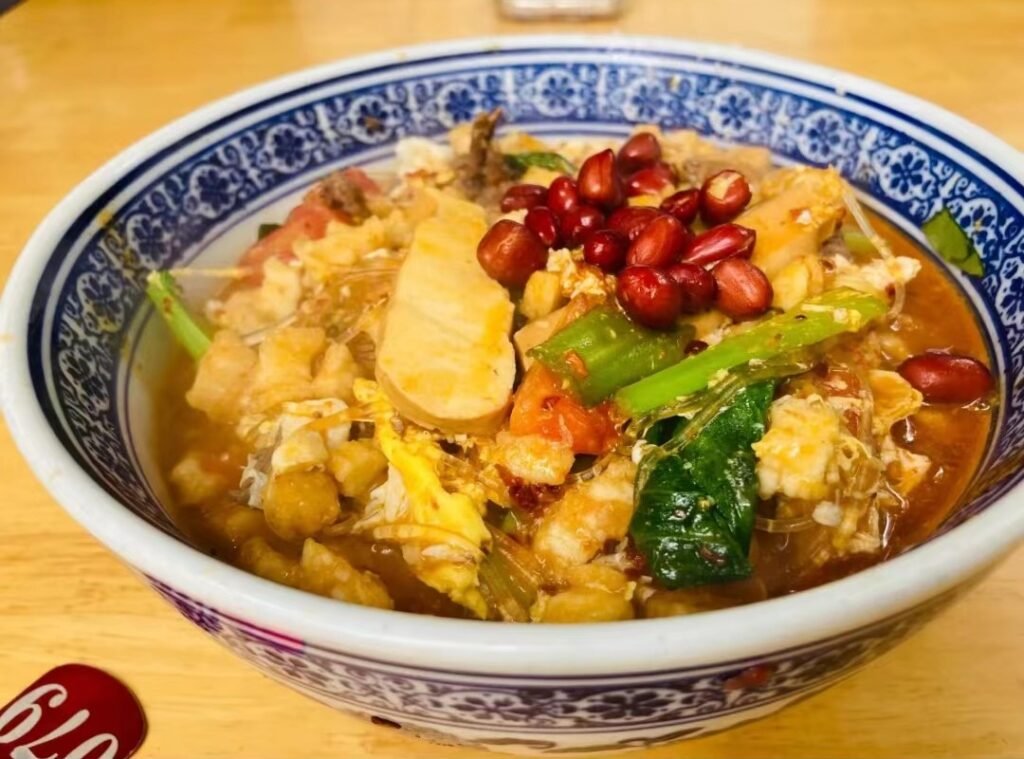
Similar to Mutton and Bread Pieces in Soup, Stir-Fried Crumbled Flatbread is also a halal specialty of the Muslim community, but the preparation method differs. While traditional Pao Mo is boiled, Stir-Fried Crumbled Flatbread is stir-fried. In terms of ingredients, Stir-Fried Crumbled Flatbread includes additional ingredients such as yellow flower vegetables, black fungus, green vegetables, tofu skin, and sliced beef. It is stir-fried with chili oil and vinegar. Stir-Fried Crumbled Flatbread combines the rich and hearty flavor of Pao Mo with a refreshing and spicy taste.
6. Biangbiang 面 (Biangbiang Noodles)

Ku Dai Mian, commonly known as Biangbiang noodles, is a traditional specialty noodle dish from the Guanzhong region in Shaanxi Province. It refers to noodles made from locally grown wheat flour that are hand-stretched into long, wide, and thick strips. The name “Biangbiang” comes from the sound made during the noodle-making process. It is one of the “Eight Strangest Things in Guanzhong” and a popular street food snack in Xi’an and other areas of Guanzhong.
Biangbiang noodles are made through kneading, pulling, slapping, and stretching techniques, resulting in wide and thick noodles resembling a belt. Before consumption, the noodles are served in a broth flavored with soy sauce, vinegar, MSG, and Sichuan peppercorns, providing a satisfying chewy texture.
Biangbiang noodles have been recognized as one of the “Top Ten Famous Noodles in China” and “Top Ten Famous Snacks in China” by the Chinese Cuisine Association and Shaanxi Provincial Department of Commerce. They have also been listed among the “Top Ten Famous Snacks in Shaanxi” by the Shaanxi Provincial Department of Commerce and Shaanxi Catering Association.
7. 臊子面 (Saozi Noodles)

Saozi Noodles is a specialty traditional noodle dish in Xi’an, Shaanxi Province. It is a famous snack in the West Palace area and popular in the Guanzhong Plain of Shaanxi and eastern Gansu.
Saozi Noodles has a long history and typically includes ingredients such as tofu and eggs, with a simple cooking method. “Sào Zi” refers to diced meat. The color combination is particularly important for locals, with yellow egg skin, black wood ear mushrooms, red carrots, green garlic sprouts, and white tofu, creating an attractive and delicious dish.
The noodles in Saozi Noodles are thin, even, and have a delightful chewiness. The meat is tender, and the soup is slightly spicy and sour. It offers a satisfying texture, suitable for people of all ages. Saozi Noodles holds a significant position in the Guanzhong region and is an essential part of important occasions such as weddings, funerals, festivals, baby’s first month, elderly birthdays, and welcoming guests.
8. 油泼面 (Oil-Splashed Noodles)

Oil-Splashed Noodles is a traditional specialty noodle dish in Shaanxi Province that originated in the Ming Dynasty. It is known for its savory, spicy, and aromatic flavors.
Handmade noodles are cooked in boiling water, placed in a bowl, and topped with chopped green onions, Sichuan peppercorn powder, salt, and a generous layer of chili flakes. Then, hot oil is poured over the seasoning, creating a sizzling effect and infusing the noodles with the flavors of the spices. Finally, soy sauce and vinegar are added to enhance the taste. It can also be served with additional ingredients such as marinated meat, shredded green peppers and potatoes, scrambled eggs with green peppers, and tomatoes with eggs.
9. 胡辣汤 (Spicy Soup)

Spicy Soup is a specialty street food in Xi’an, known for its spicy and sour flavors. It is available in two versions: vegetarian and meatball. Vegetarian Spicy Soup is often served with pan-fried buns and youtiao (fried dough sticks), while meatball Spicy Soup is served with Bai Ji Mo (a type of flatbread). Locals typically enjoy vegetarian Spicy Soup for breakfast and meatball Spicy Soup for lunch or dinner.
Spicy Soup has a thick and sticky broth with plentiful meatballs. It features a strong numbing sensation from Sichuan peppercorns. The combination of flavorful meatballs and nutritious vegetables is enhanced by a spoonful of chili oil, which adds a distinctive element to the soup and makes it irresistible.
10. 灌汤包 (Soup Dumplings)

Soup Dumplings is a specialty found in many regions of China. Typically, the filling contains aspic to create a soupy texture. However, in Xi’an, Soup Dumplings has a halal flavor, and no aspic or gelatinous ingredients are used. Instead, the filling consists of high-quality lamb rib meat and a rich bone marrow broth. The meat is finely processed, combined with a special blend of more than ten seasonings and the bone broth. This results in juicy soup-filled buns that are both flavorful and delightful.
11. 酸汤水饺 (Sour Soup Dumplings)
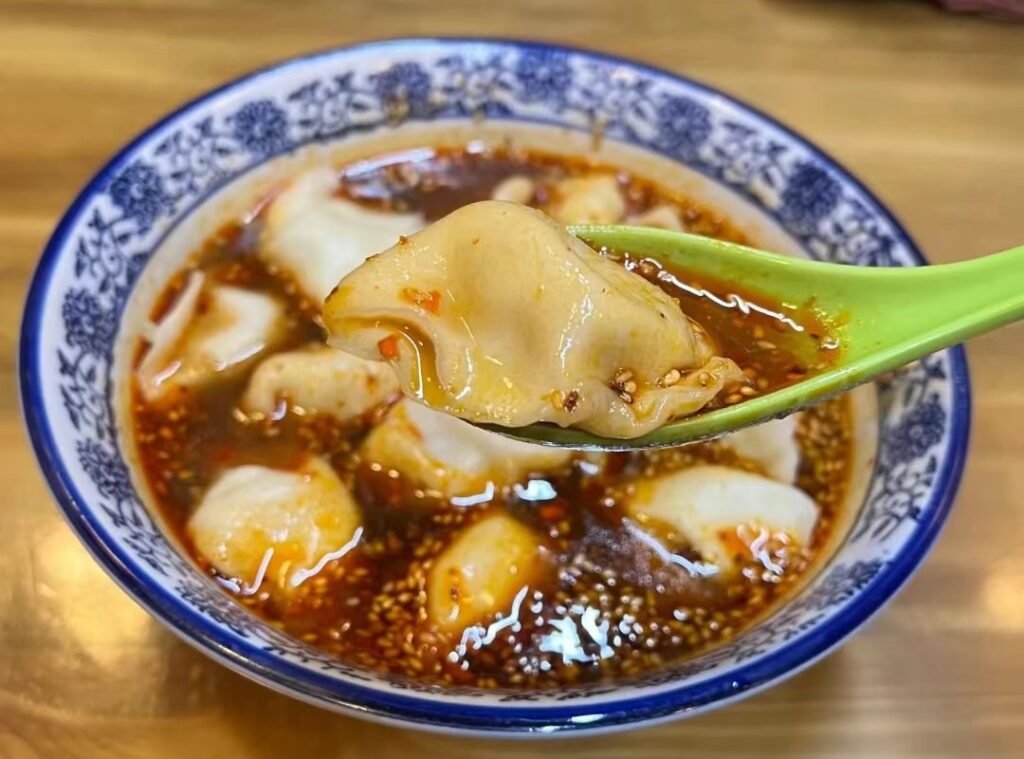
As the name suggests, Sour Soup Dumplings are known for their sour broth, but the dumplings themselves are also incredibly delicious. Common fillings include pork, lamb, and seafood, with lamb being the most popular.
These dumplings are typically handmade and sold fresh. They feature a large filling-to-wrapper ratio, resembling a meatball. When shaping the dumplings, the dough is pinched closed with both hands, and the thumbs are pressed inward, creating a dumpling with a ruffled edge. Hence, they are also called “Yang Rou Ge Da” or “Zhu Rou Ge Da,” which means lamb or pork dumplings with ruffled edges.
12. 甑糕 (Glutinous Rice and Date Cake)

Glutinous Rice and Date Cake is a traditional snack unique to Xi’an and the Guanzhong region. It is made by steaming glutinous rice with red dates or honey dates and red beans in a special iron steamer called “zeng.” This snack has a long history. “Zeng” refers to an ancient steamer in China, which can be made of pottery, copper, or iron. The iron zeng has been preserved through folk traditions, and the sticky rice cake steamed in it has its own unique flavor.
13. 镜糕 (Mirror Cake)

Mirror Cake is a traditional snack from Xi’an, Shaanxi Province, primarily enjoyed by the Hui ethnic group. It is small and round like a mirror, and no thicker than a finger. The cake is made by finely grinding glutinous rice into flour, placing a thin iron sheet in a small bamboo or wooden steaming basket, filling it with the rice flour, sprinkling it with brown sugar, green and yellow-colored sugars, and finely chopped red and green threads. The baskets are stacked and steamed until cooked.
14. 桂花糕 (Osmanthus Cake)

Osmanthus Cake, with a history of over 300 years, is a traditional Chinese snack made from glutinous rice flour, sugar, and osmanthus honey. It has a long history and comes in various types. The cake has a sweet and pleasant flavor with a rich osmanthus fragrance.
The bottom of the Osmanthus Cake is golden brown, while the cake itself is golden and has a soft and delicate texture. Its appearance is unique, as most vendors make the Osmanthus Cake into a thick round cake. When customers buy it, the vendor uses a special knife to cut it, creating a gear-like pattern around the cake, making it visually appealing.
15. 黄桂柿子饼 (Osmanthus Persimmon Cake)
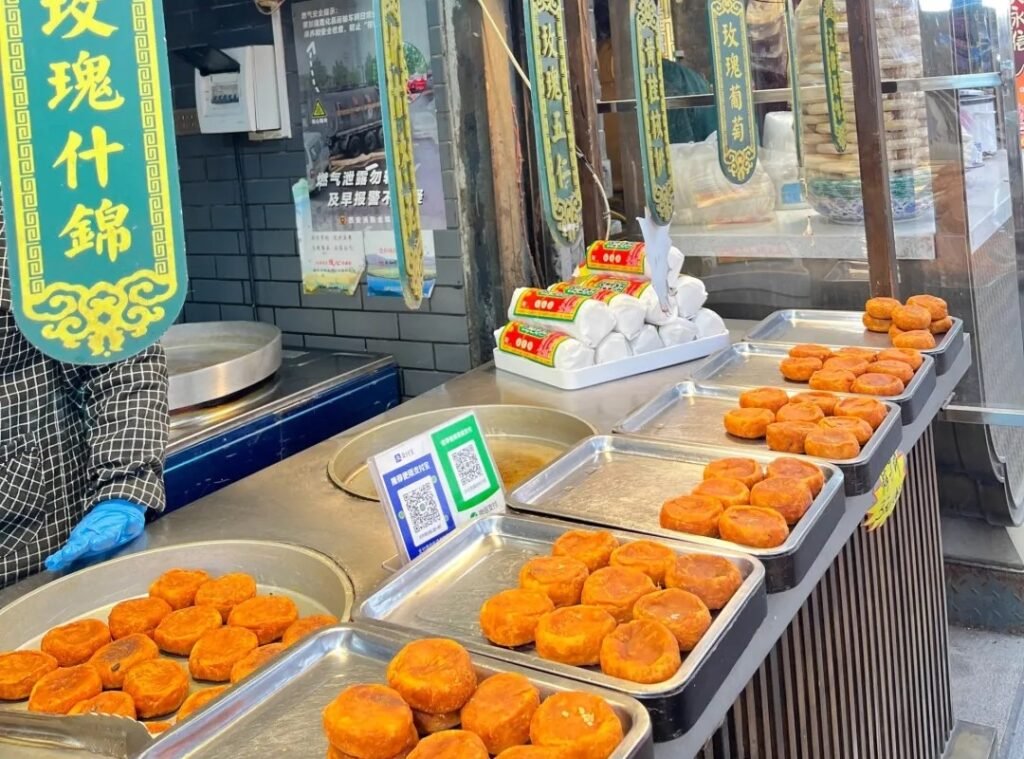
Osmanthus Persimmon Cake is often misunderstood by many tourists as a cake made by directly pressing persimmons into a flat shape. However, authentic Persimmon Cake is made with “Huo Jing Persimmons” from Lintong and dough as the pastry. It is then filled with ingredients like yellow osmanthus, rose, or mixed nuts and deep-fried.
When eating, it is best to break open the Osmanthus Persimmon Cake while it’s hot and enjoy the filling and soft persimmon first before savoring the crispy crust. It must be eaten hot to fully appreciate its deliciousness.
16. 金线油塔 (Crispy Fried Noodles)

Crispy Fried Noodles is a precious traditional snack from Sanyuan, Shaanxi Province. It features thin, soft layers that resemble golden threads, earning it the name “Crispy Fried Noodles.”
The appearance of Crispy Fried Noodles is reminiscent of intertwined golden threads, while the texture is fluffy, soft, and not greasy. It is rich in nutrients. When eating, it is usually served with pickled vegetables, sweet bean sauce, and scallion segments. Adding almond sweet syrup enhances its refreshing and delightful flavor.
17. 千层油酥饼 (Flaky Pastry)
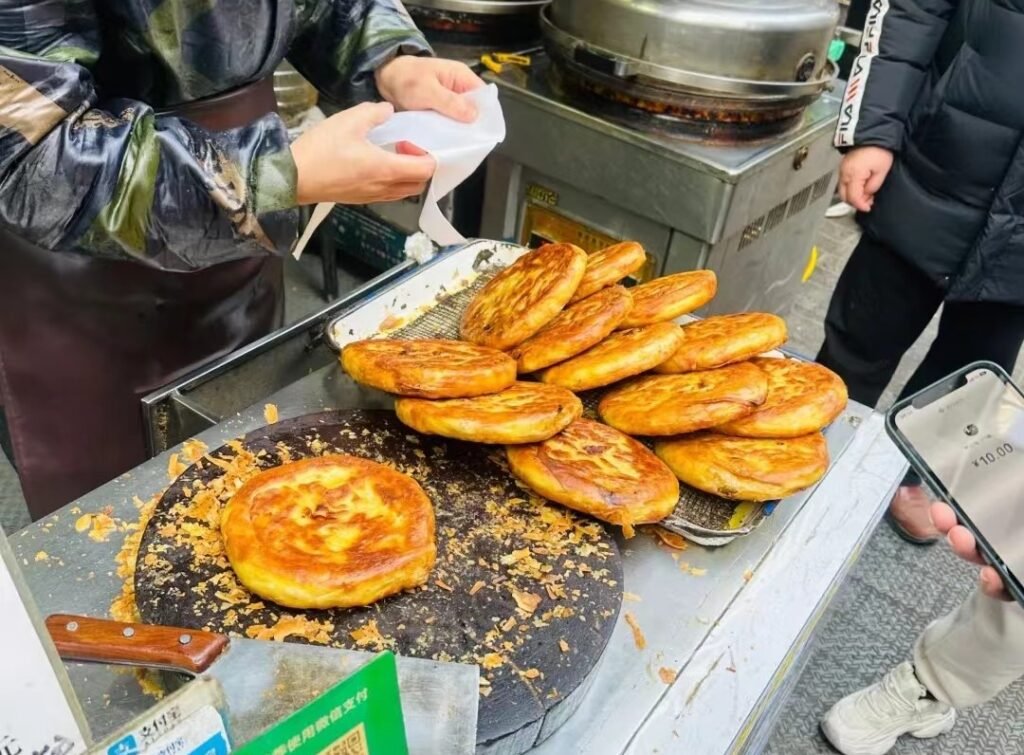
Flaky Pastry is known for its golden color, distinct layers, crispy yet not brittle texture, and savory aroma. It is hailed as the “top pastry in Western Qin.” Originating from the Tang Dynasty, it was created to reward Xuanzang, a famous monk who had translated Buddhist scriptures and returned to Chang’an. The imperial chefs specially fried the “thousand-layer pancake” in vegetable oil and presented it to Xuanzang as a token of appreciation. Through continuous improvements by generations of chefs, it became known as Flaky Pastry.
Flaky Pastry is made through processes such as laminating, dough mixing, pastry making, and grilling. Its crispy crust remains intact without breaking, and the layers are distinct. It has been recognized as one of the “Top Ten Famous Snacks in Shaanxi” by the Shaanxi Provincial Department of Commerce and the Shaanxi Catering Association. It has also received accolades such as the “Golden Tripod Award” and the title of “Chinese Famous Snack.”
18. 蜂蜜凉粽子 (Honey Glutinous Rice)
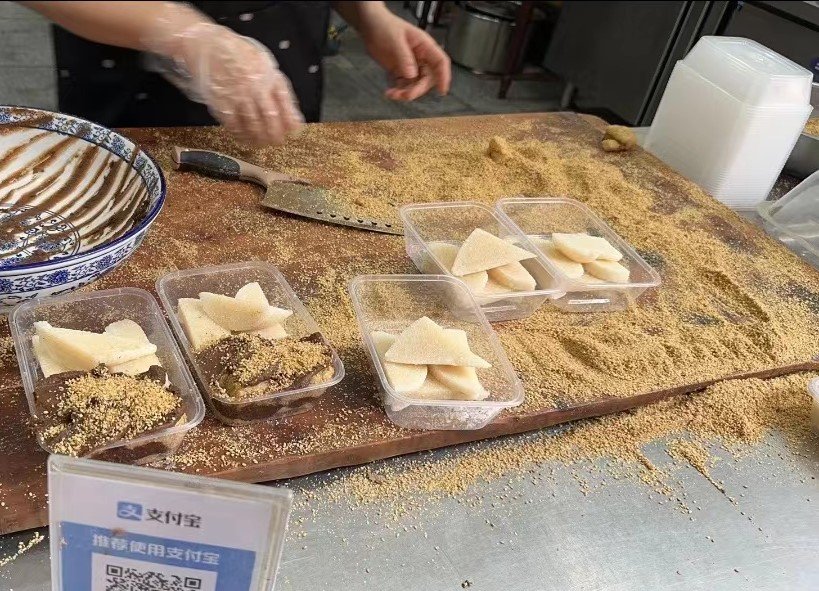
Honey Glutinous Rice is a popular summer snack unique to Xi’an, Guanzhong, and southern Shaanxi. Resembling a diamond shape, it has a glossy white appearance, offering a cool and refreshing taste. To eat, the dumpling is sliced with thread or a bamboo knife, placed on a plate, and drizzled with honey or rose and osmanthus syrup. It is soft, cool, sweet, aromatic, and leaves a delightful aftertaste. During the summer season in the ancient city of Xi’an, these glutinous rice dumplings, made solely from glutinous rice without any fillings or fruits, become a sought-after treat.
19. 油茶麻花 (Fried Dough Twists with Oil Tea)

Fried Dough Twists with Oil Tea is a traditional street snack from Han City, Xi’an, Shaanxi. The dough twists are soaked in oil tea until they become soft and are then eaten. At this point, the fragrance of the oil, dough, and the crushed sesame, almonds, soybeans, and peanuts combine to satisfy hunger.
Oil tea is a characteristic street food made by frying wheat flour and almonds or fried tofu skin with seasoning such as Sichuan peppercorn powder in vegetable oil. Fried Dough Twists, also known as twisted dough sticks, is a fried snack made by twisting two or three strands of dough together and deep-frying them until golden brown. Fried Dough Twists is eye-catching, with a sweet and crispy taste that is not greasy. It has a refreshing flavor and leaves a pleasant aftertaste. It can be enjoyed without feeling heavy even when consumed in large quantities.
20. 葫芦鸡 (Gourd Chicken)

Gourd Chicken, originating from the Tang Dynasty, is known as the “first flavor of Chang’an” and is a famous specialty dish in Shaanxi. It features a golden-red color, crispy skin, tender meat, and a rich and savory flavor.
The preparation of Gourd Chicken involves boiling, steaming, and deep-frying. First, the chicken is washed in clear water to remove impurities. Then, it is tied with hemp threads to maintain its shape. After bringing water to a boil, the chicken is added and cooked for half an hour before being transferred to a serving platter. Meat broth, cooking wine, salt, soy sauce, scallions, ginger, star anise, and cinnamon are added, and the chicken is steamed until fully cooked. Lastly, the chicken is deep-fried in hot rapeseed oil until golden brown. It is served with a side of Sichuan peppercorn salt for an extra touch of flavor.
Famous Local Food Streets in Xi'an
If you want to taste the delicacies listed above, you don’t need to travel back and forth between various locations. Most of these foods can be enjoyed in the same food street. Below are some recommended food streets in Xi’an:
- Huimin Street: A popular food culture street near tourist attractions, offering a wide variety of local specialty snacks.
- Yongxingfang: A gathering place for trendy shops, it is the first cultural-themed street in the country dedicated to intangible cultural heritage.
- Sajinqiao: A budget-friendly street frequented by locals, known for its vibrant atmosphere and affordable snacks.
- Zhonglou Neighborhood: A hidden food paradise, featuring food stalls and eateries where locals have been enjoying delicious food since childhood.
- Xiaonanmen Night Market: The largest night market for barbecue under the Xi’an City Wall, exuding a lively and authentic local atmosphere.
- Hongjie Night Market: A must-visit night market for food lovers, offering affordable prices and a wide range of food options.
Conclusion
In this blog, we explored the local culinary delights of Xi’an, a city rich in history and diverse food culture. From the renowned Biangbiang noodles and Chinese Hamburger to the flavorful Liang Pi and Basin Mutton, Xi’an offers a plethora of delicious options. The city’s iconic dishes, such as Mutton and Bread Pieces in Soup and Stir-Fried Crumbled Flatbread, showcase the unique flavors and textures that have delighted both locals and visitors alike. Additionally, we discovered delightful treats like Osmanthus Cake and Osmanthus Persimmon Cake, showcasing the city’s vibrant dessert scene. To fully experience Xi’an’s culinary wonders, one can explore the famous food streets like Huimin Street and Yongxingfang, where a variety of local delicacies can be savored. Whether you’re a food enthusiast or a curious traveler, Xi’an’s local cuisine is sure to leave a lasting impression and satisfy your taste buds.



